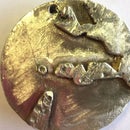Introduction: How to Create a Laser Cut Lamp
Laser cutting, in simple terms, is using a high beam (or a laser) at various speeds and power to cut/etch a specific material. Laser cutters are similar to how a printer operates. It is by using a laser beam reflect an image onto something, except it cuts it out.
Step 1: Download the Software
For this project, you will need two apps: Processing and Inkscape. Make sure you download the right file for your computer (If you have an Apple then don't download the Windows version) You will need Processing to edit your design, and Inkscape to put the code in the right format. Also, make sure your Java is up to date. You will need that to run the code from Processing.
Step 2: Edit Your Design.
In the Processing folder, you should find another folder called "codeableObjects." Drag the codeableObjects folder into the folder that is called "Libraries." (IMPORTANT: Libraries is NOT the same as Library) Open up codeableObjects and choose a design (Polar Rose, Random, Spiral, etc.) Open the file, and press the play button. A pop-up in the Java application should appear, which shows a prism with sliders (see the image above.) Adjust these sliders until you get the design you want. ANOTHER IMPORTANT THING: You will want to change the bottom base position to fit the bottom part of your lightbulb.
Step 3: Convert the Processing File to Inkscape
After making the design you want, you need to convert it to Inkscape. Press the save button in Processing, and open up Inkscape. (You may need to force quit the application and open it again) Under the tab File, click Open, and select the file in the Processing folder. Choose the file pattern.pdf, your design should show the shade of your lamp you want to make. The design most likely will not fit in the box. If it doesn't, read the steps below, if it does, skip it.
If your design doesn't fit in the box, select the area so that the box has a dashed line around it. Under the Object tab, select Ungroup. If the lines don't come out the box, select Object-Mask-Release. Then try Object-Ungroup. All of the pieces should be visible.
Even if all of your design fit into the box, under the Object tab, press Ungroup until every single movement that will be made by the laser cutter is highlighted. At this point, the design should look somewhat like the third image, depending on your original design. Select each side of the lamp and space it apart from the rest. Under File, click Document Properties. Change the size to fit your design. If the design seems too big or too small to the size of the square, you might want to change the size of it. (For example, if my design only just fits an A0 piece of paper, I probably want to make it a bit smaller)
Finally, under the tab File, click Save As. Most laser cutters use .dxf files, so select the Desktop Cutting Plotter. If you are going to make a prototype (next step) you will want to save it as a PDF document as well.
Now, all you need to do is repeat the whole process with the file parts.pdf! (IMPORTANT: Make sure there are enough legs for each side of your model.)
Step 4: Make a Prototype (optional, But Recommended)
With the two PDF files from the previous step, print the files onto paper. Glue the sheet with the structure of the lamp onto some cardboard, but DO NOT do the same with the patterned paper. With a crafting knife, cut out the pieces, and with a hot glue gun/liquid glue, stick the pieces together. Make sure that they fit. Then, with one of the patterned lamp shade pieces, copy the design onto card. It looks better if you use a ruler for the inside design.
Assess if you have any mistakes. Personally, I forgot to leave room for my lightbulb at the bottom of the lamp, and the space for the lightbulb was too large, so I went back to edit it in Processing.
PC: The photo is of Eshan and Ibrahim's prototype. :)
Step 5: Laser Cut Your Lamp
The laser cutter should (hopefully) recognise the .dxf files and laser cut your lamp. :)
Photo: http://manyphotons.com/wp-content/uploads/Hive-1-r-682x1024.jpg









